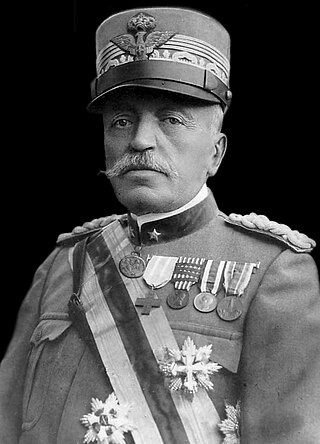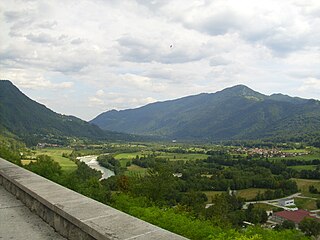
Kobarid is a settlement in Slovenia, the administrative centre of the Municipality of Kobarid.

The Battle of Caporetto took place on the Italian front of World War I.

The Yugoslav People's Army, also called the Yugoslav National Army, was the military of the Socialist Federal Republic of Yugoslavia and its antecedents from 1945 to 1992.

The Austro-Hungarian Army, also known as the Imperial and Royal Army, was the principal ground force of Austria-Hungary from 1867 to 1918. It consisted of three organisations: the Common Army, the Imperial-Royal Landwehr and the Royal Hungarian Honvéd.

The Eight-Nation Alliance was a multinational military coalition that invaded northern China in 1900 during the Boxer Rebellion, with the stated aim of relieving the foreign legations in Beijing, which was being besieged by the popular Boxer militiamen, who were determined to remove foreign imperialism in China. The allied forces consisted of about 45,000 troops from the eight nations of Germany, Japan, Russia, Britain, France, the United States, Italy, and Austria-Hungary. Neither the Chinese nor the quasi-concerted foreign allies issued a formal declaration of war.

The Italian front was one of the main theatres of war of World War I. It involved a series of military engagements along the border between the Kingdom of Italy and Austria-Hungary from 1915 to 1918. Following secret promises made by the Allies in the 1915 Treaty of London, the Kingdom of Italy entered the war on the Allied side, aiming to annex the Austrian Littoral, northern Dalmatia and the territories of present-day Trentino and South Tyrol. The front soon bogged down into trench warfare, similar to that on the Western Front, but at high altitudes and with extremely cold winters. Fighting along the front displaced much of the local population, and several thousand civilians died from malnutrition and illness in Italian and Austro-Hungarian refugee camps.

Marshal of Italy Luigi Cadorna, was an Italian general, Marshal of Italy and Count, most famous for being the Chief of Staff of the Italian Army from 1914 until 1917 during World War I. Commanding the Italian army on the Italian front, he acquired a reputation for rigid discipline and the harsh treatment of his troops. Cadorna launched multiple offensives across the Isonzo front during which the Italian army made gradual gains, notably capturing Gorizia after containing the Strafexpedition, but suffered heavy casualties. Following a major defeat at the Battle of Caporetto in late 1917, he was relieved as Chief of Staff.

The Battle of Vittorio Veneto was fought from 24 October to 3 November 1918 near Vittorio Veneto on the Italian Front during World War I. After having thoroughly defeated Austro-Hungarian troops during the defensive Battle of the Piave River, the Italian army launched a great counter-offensive: the Italian victory marked the end of the war on the Italian Front, secured the dissolution of the Austro-Hungarian Empire and contributed to the end of the First World War just one week later. The battle led to the capture of over 5,000 artillery pieces and over 350,000 Austro-Hungarian troops, including 120,000 Germans, 83,000 Czechs and Slovaks, 60,000 South Slavs, 40,000 Poles, several tens of thousands of Romanians and Ukrainians, and 7,000 Austro-Hungarian loyalist Italians and Friulians.

The Battle of Doberdò took place near Doberdò del Lago in August 1916 between armies of Kingdom of Italy and Austria-Hungary. The Austro-Hungarian army was primarily made up of regiments filled with Hungarians and Slovenians. The battle was a part of the sixth battle of the Isonzo, and occurred in a strategic area of westernmost edge of the Karst Plateau. Italians had already conquered the lowland area surrounding Monfalcone and Ronchi, and attempted to push over the Karst Plateau to seize control of the major road that linked the city of Trieste and its port with Gorizia. After fierce combat, and sustained heavy casualties, Italian forces forced Austro-Hungarian forces to retreat and captured Gorizia.

The Slovene Home Guard was a Slovene anti-Partisan collaborationist militia that operated during the 1943–1945 German occupation of the formerly Italian-annexed Slovene Province of Ljubljana. The Guard consisted of former Village Sentries, part of Italian-sponsored Anti-Communist Volunteer Militia, re-organized under Nazi command after the Italian Armistice of September 1943.

Although a member of the Triple Alliance, Italy did not join the Central Powers – Germany and Austria-Hungary – when the war started with Austria-Hungary's declaration of war on Serbia on 28 July 1914. In fact, the two Central Powers had taken the offensive while the Triple Alliance was supposed to be a defensive alliance. Moreover the Triple Alliance recognized that both Italy and Austria-Hungary were interested in the Balkans and required both to consult each other before changing the status quo and to provide compensation for whatever advantage in that area: Austria-Hungary did consult Germany but not Italy before issuing the ultimatum to Serbia, and refused any compensation before the end of the war.

The Mechanized Brigade "Pinerolo" is a mechanized infantry brigade of the Italian Army, based in the southern region of Apulia. Carrying the name of the Piedmontese city of Pinerolo the brigade's coat of arms was modeled after the city's coat of arms. The brigade is part of the Division "Acqui".

Franjo Malgaj was a Slovenian soldier, military leader and poet. He was an officer of the Austro-Hungarian Army. After the dissolution of the Austro-Hungarian Empire after World War I, he became one of the commanding officers in the Slovene volunteer army under Rudolf Maister's command that fought against German Austrian units during the struggle for the northern Slovenian borderlands. He later became an officer in the Army of Kingdom of Serbs, Croats and Slovenes. He died during the Austrian-Yugoslav struggles in 1919. He is considered a Slovenian national hero.
The Green Cadres, or sometimes referred to as; Green Brigades or Green Guards, were originally groups of Austro-Hungarian Army deserters in the First World War. They were later joined by peasants discontented with wartime requisitioning, taxation, and poverty. A substantial number of desertions to the Green Cadres occurred as early as 1914, with their numbers peaking in the summer of 1918. They were present in nearly all areas of Austria-Hungary, but particularly large numbers were found in Croatia-Slavonia, Bosnia, Western Slovakia and Moravia, as well as in Galicia. The Green Cadres had no centralised structure and relied on peasants and banditry for food and shelter. As Austria-Hungary fell apart in October 1918, violent outbreaks associated with the Green Cadres peaked. These occurrences were particularly severe in Croatia-Slavonia, Slovakia and Galicia. "Greens" were also present in large areas of the Russian Empire, particularly in present-day Ukraine, however, this page is only about the Green Cadre in the former Austro-Hungarian Monarchy.

The Battles of the Isonzo were a series of twelve battles between the Austro-Hungarian and Italian armies in World War I mostly on the territory of present-day Slovenia, and the remainder in Italy along the Isonzo River on the eastern sector of the Italian Front between June 1915 and November 1917.

The Municipality of Kobarid is a municipality in the Upper Soča Valley in western Slovenia, near the Italian border. The seat of the municipality is the town of Kobarid.
Events from the year 1915 in Italy.
The Austro-Slovene conflict in Carinthia was a military engagement that ensued in the aftermath of World War I between forces loyal to the State of Slovenes, Croats and Serbs and later the Kingdom of Serbs, Croats and Slovenes, and forces loyal to the Republic of German-Austria. The main theater of the conflict was the linguistically mixed region in southeastern Carinthia. The conflict was settled by the Treaty of Saint-Germain in 1919, which stipulated that the territorial dispute be resolved by a plebiscite.

Vincenzo Garioni was an Italian general who saw combat in the Boxer Rebellion, Italo-Turkish War, and World War I. He was the governor of Tripolitania from 1913 to 1914 and later served as the governor of both Tripolitania and Cyrenaica from 1918 to 1919.

The 13th infantry Regiment "Pinerolo" is an active unit of the Italian Army based in Bari in Apulia. The regiment is named for the city of Pinerolo and part of the Italian Army's infantry arm. On 1 October 2022, the name, flag and traditions of the regiment were assigned to the Command and Tactical Supports Unit "Pinerolo" of the Mechanized Brigade "Pinerolo". On the same day the unit was renamed 13th Command and Tactical Supports Unit "Pinerolo". The regiment was formed on 19 December 1821 by the Royal Sardinian Army as Brigade of "Pinerolo", with the troops of the Brigade of "Saluzzo", who had remained loyal during the revolt in Piedmont in spring 1821 and were retained in service after the Brigade of "Saluzzo" was disbanded on 31 May 1821. Later the Royal Italian Army allowed the two regiments of the Brigade "Pinerolo" to claim the traditions and honors of the Brigade of "Saluzzo", for which reason the regiment's founding year is today considered to be 1672.
















